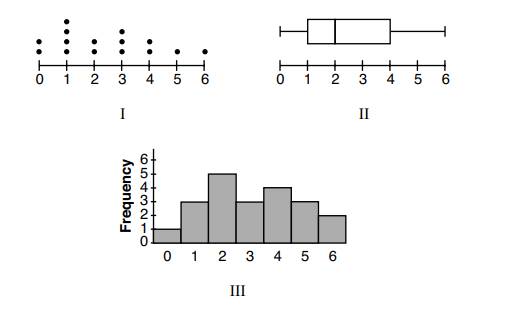This exam was adminstered in August 2022.
More Regents problems.
August 2022 Geometry Regents
Part I
Each correct answer will receive 2 credits. No partial credit.
6. On the set of axes below, △RST is the image of △ABC after a
dilation centered at point P.
The scale factor of the dilation that maps △ABC onto △RST is
(1) 1/3
(2) 2
(3) 3
(4) 2/3
Answer: (1) 1/3
AB has a length of 3 and RS has a length of 1. Going from ABC to RST, the triangle is reduced by a factor of 3, so the dilation is 1/3, which is Choice (1).
Mapping RST onto ABC would be a dilation of 3.
7. In the diagram of △ABC below, m∠C = 90°, CB = 13, and AB = 16.
What is the measure of ∠A, to the nearest degree?
(1) 36°
(2) 39°
(3) 51°
(4) 54°
Answer: (4) 54°
We know the opposite side from angle A and we know the hypotenuse. So we need to use the inverse of the sine ratio to find the size of the angle.
sin-1(13/16) = 54.3, or about 54 degrees.
If you did cosine instead, you would have gotten 36 degrees.
If you did tangent instead, you would have gotten 39 degrees.
If you did tangent and swapped the two side lengths, you would have gotten 51 degrees.
8. The Pyramid of Memphis, in Tennessee, stands 107 yards tall and
has a square base whose side is 197 yards long.
What is the volume of the Pyramid of Memphis, to the nearest
cubic yard?
(1) 751,818
(2) 1,384,188
(3) 2,076,212
(4) 4,152,563
Answer: (2) 1,384,188
The Volume of a square pyramid is given by the formula V = (1/3)s2h.
V = (1/3)s2h
= (1/3)(197)2(107)
= 1384187.66...
This is Choice (2).
If you forgot the (1/3), you would've gotten Choice (4), which is incorrect.
If you used (1/2), you would've gotten Choice (3), which is also incorrect.
9. A square is graphed on the set of axes below, with vertices at
(1,2), (1,2), (3,2), and (3,2).
Which transformation would not carry the square onto itself?
(1) reflection over the y-axis
(2) reflection over the x-axis
(3) rotation of 180 degrees around point (1,0)
(4) reflection over the line y = x - 1
Answer: (1) reflection over the y-axis
Reflecting (3,2) over the y-axis maps it to (-3,2), which is not part of the square. So Choice (1) is correct.
In Choice (2), reflecting over the x-axis will switch the signs of the y-coordinate. -2 will map to 2 and 2 will mapt to -2. This parts are still on the square.
In Choice (3), the key is that the center is (1,0), which is the center of the square. Rotating a square 180 degrees around its center will map it onto itself.
In Choice (4), the line y = x - 1 is the diagonal of the square. (You can graph it if you don't believe me.) Reflecting a square across its diagonal will make it onto itself.
Squares have diagonals that are perpendicular and congruent, so this is incorrect.
Rhombuses (rhombi) have diagonals that are perpendicular. If they are also congruent, then the rhombus is also a square, but they do NOT have to be congruent.
A rectangle has diagonals that are congruent. If they are also perpendicular, then the rectangle will be a square.
An isosceles trapezoid has congruent diagonals.
10. If scalene triangle XYZ is similar to triangle QRS and m∠X = 90°,
which equation is always true?
(1) sin Y = sin S
(2) cos R = cos Z
(3) cos Y = sin Q
(4) sin R = cos Z
Answer: (4) sin R = cos Z
Since the triangle is scalene, the acute angles are not equal to each other. Therefore the sines of those angles cannot equal each other and the cosines of those angles cannot equal each other.
Angles Q and X are right angles.
The sine of R = the sine of Y, and the cosine of R = the cosine of Y.
The sine of S = the sine of Z, and the cosine of S = the cosine of Z.
The sine of R = the cosine of Z, and the cosine of R = the sine of Z.
The sine of S = the cosine of Y, and the cosine of S = the sine of Y.
The correct answer is Choice (4).
More to come. Comments and questions welcome.
More Regents problems.




































